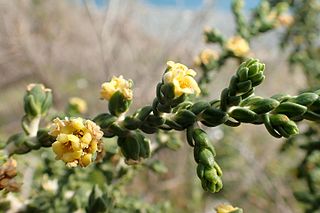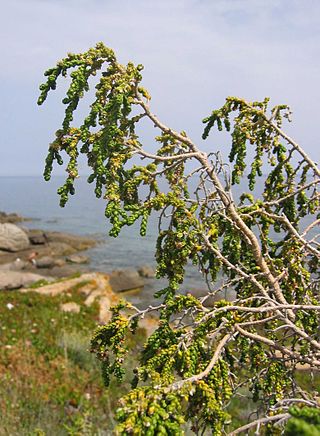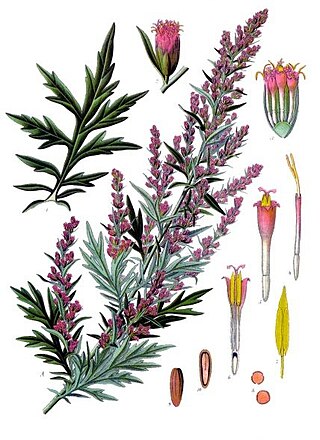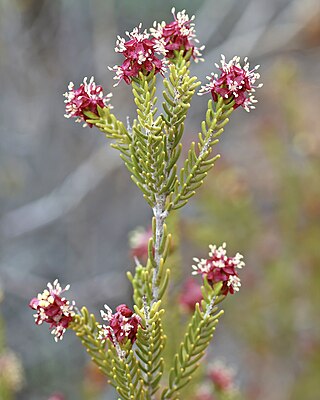
Alders are trees that compose the genus Alnus in the birch family Betulaceae. The genus includes about 35 species of monoecious trees and shrubs, a few reaching a large size, distributed throughout the north temperate zone with a few species extending into Central America, as well as the northern and southern Andes.

Salvia rosmarinus, commonly known as rosemary, is a shrub with fragrant, evergreen, needle-like leaves and white, pink, purple, or blue flowers. It is native to the Mediterranean region, as well as Portugal and Spain. Until 2017, it was known by the scientific name Rosmarinus officinalis, now a synonym.

Sisal is a species of flowering plant native to southern Mexico, but widely cultivated and naturalized in many other countries. It yields a stiff fibre used in making rope and various other products. The sisal fibre is traditionally used for rope and twine, and has many other uses, including paper, cloth, footwear, hats, bags, carpets, geotextiles, and dartboards. It is also used as fibre reinforcements for composite fibreglass, rubber, and concrete products. It can also be fermented and distilled to make mezcal.

Willows, also called sallows and osiers, of the genus Salix, comprise around 350 species of typically deciduous trees and shrubs, found primarily on moist soils in cold and temperate regions.

Potentilla is a genus containing over 500 species of annual, biennial and perennial herbaceous flowering plants in the rose family, Rosaceae.

Bearberries are three species of dwarf shrubs in the genus Arctostaphylos. Unlike the other species of Arctostaphylos, they are adapted to Arctic and subarctic climates, and have a circumpolar distribution in northern North America, Asia and Europe.

Hypericum is a genus of flowering plants in the family Hypericaceae. The genus has a nearly worldwide distribution, missing only from tropical lowlands, deserts and polar regions. Many Hypericum species are regarded as invasive species and noxious weeds. All members of the genus may be referred to as St. John's wort, and some are known as goatweed. The white or pink flowered marsh St. John's worts of North America and eastern Asia are generally accepted as belonging to the separate genus TriadenumRaf.

The Thymelaeaceae are a cosmopolitan family of flowering plants composed of 50 genera and 898 species. It was established in 1789 by Antoine Laurent de Jussieu. The Thymelaeaceae are mostly trees and shrubs, with a few vines and herbaceous plants.

Croton is an extensive plant genus in the spurge family, Euphorbiaceae. The plants of this genus were described and introduced to Europeans by Georg Eberhard Rumphius. The common names for this genus are rushfoil and croton, but the latter also refers to Codiaeum variegatum. The generic name comes from the Greek κρότος, which means "tick" and refers to the shape of the seeds of certain species.

Agathosma is a genus of about 140 species of flowering plants in the family Rutaceae, native to the southern part of Africa. Common names include buchu, boegoe, bucco, bookoo and diosma. Buchu formally denotes two herbal species, prized for their fragrance and medicinal use despite their toxicity. In colloquial use however, the term is applied to a wider set of fragrant shrubs or substitutes.

Thymelaea is a genus of about 30 species of evergreen shrubs and herbs in the flowering plant family Thymelaeaceae, native to the Canary Islands, the Mediterranean region, north to central Europe, and east to central Asia.

Dirca is a genus of three or four species of flowering plants in the family Thymelaeaceae, native to North America. The genus is named after Dirce in Greek mythology. The general common name for this deciduous shrub is leatherwood; other names include moosewood, ropebark and the Powhatan-derived name wicopy, referring to its use as a fiber, wigub in the Algonquin languages. The stems of Dirca are exceptionally pliable and the bark is difficult to tear by hand; for this reason, its stems were used by Native Americans in eastern North America as thongs or ropes. The inner bark has cross-linked fibers that are short but strong and flexible. Members of the genus can grow to a maximum height of about three meters, and are often associated with rich, moist woods or slopes above creeks or streams.

Mugwort is a common name for several species of aromatic flowering plants in the genus Artemisia. In Europe, mugwort most often refers to the species Artemisia vulgaris, or common mugwort. In East Asia the species Artemisia argyi is often called "Chinese mugwort" in the context of traditional Chinese medicine, Ngai Chou in Cantonese or àicǎo (艾草) for the whole plant in Mandarin, and àiyè (艾叶) for the leaf, which is used specifically in the practice of moxibustion. Artemisia princeps is a mugwort known in Korea as ssuk (쑥) and in Japan as yomogi (ヨモギ). While other species are sometimes referred to by more specific common names, they may be called simply "mugwort" in many contexts.

Passerina is a genus in the plant family Thymelaeaceae, native to southern Africa. They are ericoid bushes growing largely in fynbos and other Southern African scrub habitats.

Thymus citriodorus, the lemon thyme or citrus thyme, is a lemon-scented evergreen mat-forming perennial plant in the family Lamiaceae. There has been a great amount of confusion over the plant's correct name and origin. Recent DNA analysis suggests that it is not a hybrid or cross, but a distinct species as it was first described in 1811., yet an analysis in a different study clustered Thymus citriodorus together with Thymus vulgaris, which is considered as one of its parent species.

Fique is a natural fibre that grows in the leaves of plants in the genus Furcraea. Common names include fique, cabuya, pita, penca, penco, maguey, cabui, chuchao and coquiza.

Herbs are a widely distributed and widespread group of plants, excluding vegetables and other plants consumed for macronutrients, with savory or aromatic properties that are used for flavoring and garnishing food, for medicinal purposes, or for fragrances. Culinary use typically distinguishes herbs from spices. Herbs generally refers to the leafy green or flowering parts of a plant, while spices are usually dried and produced from other parts of the plant, including seeds, bark, roots and fruits.

Croton gratissimus, is a tropical African shrub or small tree with corky bark, growing to 8 m and belonging to the family of Euphorbiaceae or spurges. Young twigs are slender and angular and covered in silver and rust-coloured scales.

Vachellia flava, synonym Acacia ehrenbergiana, is a species of drought-resistant bush or small tree, commonly known as salam in Arabic. It is found in the Sahara, the northern Sahel, parts of East Africa, the Arabian Peninsula and Iran.

Hypericum foliosum, the shining St John's wort, is a species of flowering plant in the family Hypericaceae. It is a bushy shrub endemic to the Portuguese Azores Islands with golden yellow petals and many stems. The species was described by William Aiton in 1789 and was later placed into section Androsaemum of the genus Hypericum by Norman Robson in 1984. It has a diverse essential oil profile made up mostly of monoterpene hydrocarbons, and significant concentrations of various medicinally useful phenols and carotenoids. Populations of the plant are small in number, but quick to colonize cleared areas like groves, landslide areas, and volcanic ash deposits. It is parasitized by fungus and by moth species, but is not considered endangered by the IUCN. H. foliosum is used in traditional medicine on the Azores for diuretic, hepatoprotective, and antihypertensive purposes. It also has in vitro antibiotic and antioxidizing capabilities.























